
When it comes to perusing the grocery aisles, the amount of oatmeal and oat choices may surprise you. With so many options that appear very similar, how are you supposed to know which one to pick? Learning the different types of oats will make your next shopping trip that much easier.
Some mornings you want something quick and easy. Other mornings you want a healthy, hearty meal. So, why not have both? Oatmeal is an easy way to start the day and makes for the ultimate morning comfort food. Plus, it’s very good for you!
What are Oats?
What makes oats different from other ancient grains? Oats come from the plant Avena sativa, a grain grown to harvest the seeds… oats! A whole grain, many enjoy oats for their neutral taste and versatility.
With a ton of health benefits, those on many different diets can enjoy eating oatmeal for breakfast. Low in saturated fat and cholesterol, oats help to reduce the risk of heart disease. They are high in protein, vitamins, and minerals.
However, their high levels of fiber make oats the most popular. While different types of oats have varying levels of fiber, all have a noteworthy amount.
Are Oats Gluten-Free?
Yes! Those who are celiac or prefer a gluten-free diet can enjoy oats. However, they need to only buy oats with a certified gluten-free label.
Wheat, barley, and rye all contain the protein gluten. Instead of gluten, oats have a protein called avenins. While they don’t have gluten, oats are often grown on the same land as gluten-carrying grains.
If you plant oats on land that grew wheat the previous year, the oats will be considered contaminated with gluten. Contamination can also happen upon processing since most manufacturers will house wheat, barley, rye, or oats in the same facility.
To ensure your oats have not been contaminated, only purchase oats that are labeled as gluten-free.
Types of Oats and Oatmeal
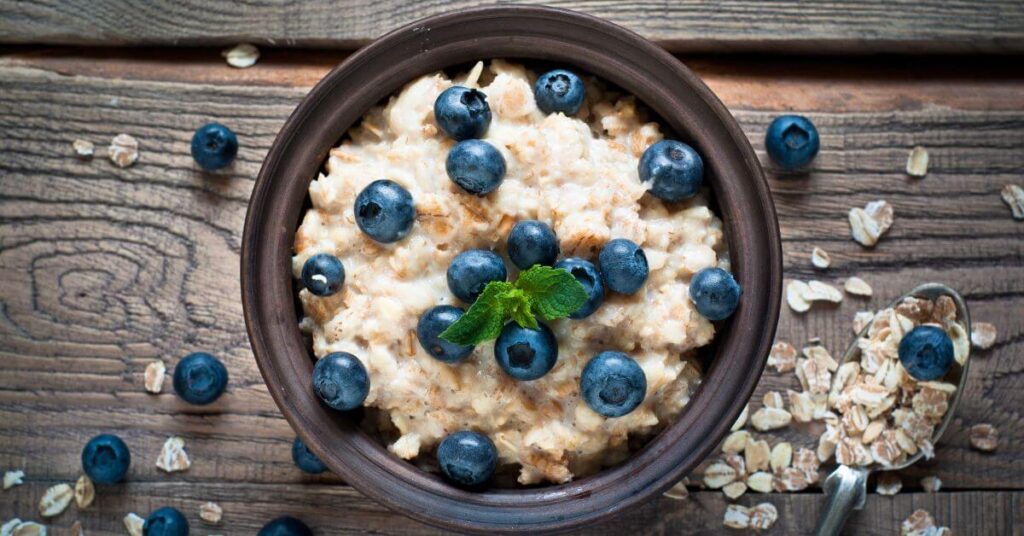
While all oatmeal may start from the same grain, the types of oatmeal all have different textures and even taste upon serving. All oatmeal begins as oat groats which are the kernels from the whole grain. Once removed from the husks, they can be processed differently to have varying textures, uses, and even digestion effects. So which types of oats work best for you? Let’s find out!
Steel-Cut Oats
A steel-cut oat is a whole oat groat that has been split into different pieces. Also known as Irish or Scottish oats, they are very chewy and hold an almost nutty flavor. As the least processed of the oats, it carries the most fiber. It also has less of an impact on blood sugar compared to more processed oats.
Steel-cut oats take the longest to cook, approximately 20 to 30 minutes on the stovetop. The larger the pieces, the longer you can expect the oats to cook. To speed up the cooking time, soak them in water overnight. The resulting oatmeal is creamy and chewy.
Rolled Oats
You may know rolled oats by their other name – old-fashioned oats. Rest assured, they are the same kind of oat. Rolled oats are first steamed to become softened and then pressed between rollers. The steaming helps stabilize the oats’ oils and extend their shelf life.
Compared to a steel-cut oat, rolled oats have a milder flavor and a softer texture. Low on the glycemic index, they cook quicker than steel-cut oats because they absorb water quickly. Ready in 10 to 15 minutes, rolled oats are good for those who don’t want anything too mushy but don’t like the chewy nature of steel-cut oats.
Most baking prefers rolled oats, including muffins, cookies, and granola bars.
Instant or Quick Oats
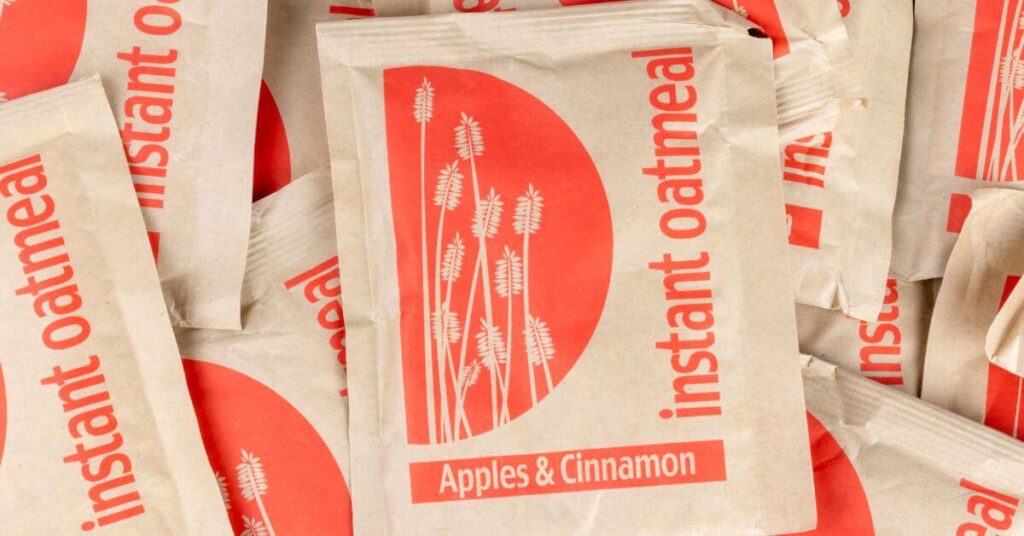
For quick oats, groats are pressed thinner than rolled oats, rolled, and then steamed longer so they can cook quickly. To decrease cooking time, most brands cut quick oats into small pieces. This gives it an almost powdery effect.
Instant oats are quick oats that have added sugar and flavoring to them. These come in individual packets and can be made in the microwave or with boiling water.
Instant and quick oats cook on the stove or microwave in a minute. Since they are absorbed by the body quicker, you may notice a small spike in blood sugar.
Other Oat Products
Oats are so much more than oatmeal. Beyond oatmeal, a few more products come from the whole grain oat.
Oat Flour
An alternative to plain wheat flour, oat flour uses the entire oat grout to turn into a fine powder. Groats are steamed, rolled, pressed, and then cut finely until they resemble a flour texture. The resulting powder tastes nutty and looks tan in color.
As a flour replacement, you can use oat flour to replace 20% of wheat in bread, cakes, and cookies. It works as a complete replacement at 100% for muffins and pancakes. Due to its consistency, oat flour may also be used to thicken gravy, sauces, and soups.
Oat Bran
For those looking for fiber, oat bran makes for a superb option. Oat bran uses the outer layer of the oat that would be disposed of for oatmeal. Without the outer shell, oats cook much faster. Extremely high in fiber, most enjoy eating oat bran in small amounts.
Oat bran works well in muffins, cakes, bread, and smoothies for an easy boost of added nutrients and fiber.
Oat Groats
If you want it all, you can have it with oat groats. Whole-grain oat groats are the entire oat that has been hulled and cleaned.
Oat groats taste good in savory food. You can cook them in side dishes, soups, stew, and grain bowls. Much more hearty than most of the oat counterparts, you cook groats like you would pasta. Boil the oats and then drain the water once fully cooked. However, it takes 50 to 60 minutes before oat groats are fully cooked.
How to Cook Different Types of Oatmeal
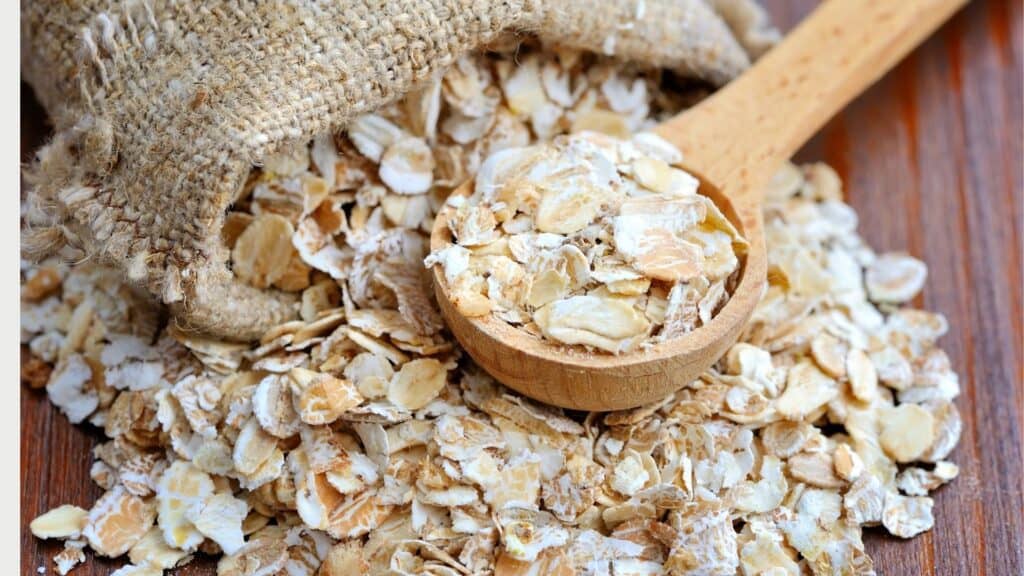
Not all types of oats are the same. Read the packaging on your oats for proper cooking times or follow one of the methods listed down below.
Stove Top
The stovetop method works best for steel-cut and rolled oats. For extra creaminess, you’ll measure 1 part oats with 2 parts of water or milk. (For example, use ½ cup of oats and 1 cup of water.)
- First, boil the water with a dash of salt.
- Stir in the oats once boiling.
- Let it cook for 20-30 minutes for steel-cut oats (or 10-15 minutes for rolled oats, or a minute for quick oats.)
Microwave
The microwave method works best for quick or instant oats. The same ratio applies for quick oats in the microwave, 1-part oats with 2-parts of water or milk.
To cook oats in the microwave:
- Mix oats and water together in a microwave-safe bowl.
- Heat on high for 1 ½ to 2 minutes.
- Stir again before eating.
Pressure Cooker
For soft and creamy oats, try a pressure cooker! Steel-cut oats work best for the pressure cooker method; otherwise, you may end up with rather mushy oatmeal.
Prior to cooking, grease your pot. Use ¾ cup of water and ¼ cup of steel-cut oats for one serving of oats. Cook for 10 minutes for chewy oats. For creamier oats, cook for 13 minutes. Don’t let it sit on the warm setting once done cooking.
Types of Oats for Baking
When it comes to baking, oats provide texture and support. While you may be tempted to replace oats with flour in a baking recipe, the effect will not be the same, and you won’t have a similar end product.
In addition to the slightly nutty taste, oats also work as a healthy alternative to many baking recipes. Choosing the right types of oats for your recipe is essential for your recipe to turn out as expected.
Typically, rolled oats (old-fashioned oats) are the preferred oat for baking. Due to their larger size and texture, they add enough support and chewiness. Fruit crumbles and oatmeal cookies especially benefit from rolled oats.
Some recipes may call for quick oats. They are more uniform in size and have less texture than a large oat. Very rarely will you see a recipe that calls for steel-cut oats. They are too hard and crunchy for baking.
Oat Recipes
Oatmeal doesn’t have to be a bland meal. Spice up your morning breakfast, or use different types of oats for other recipes!
Add Some Tasty Toppings
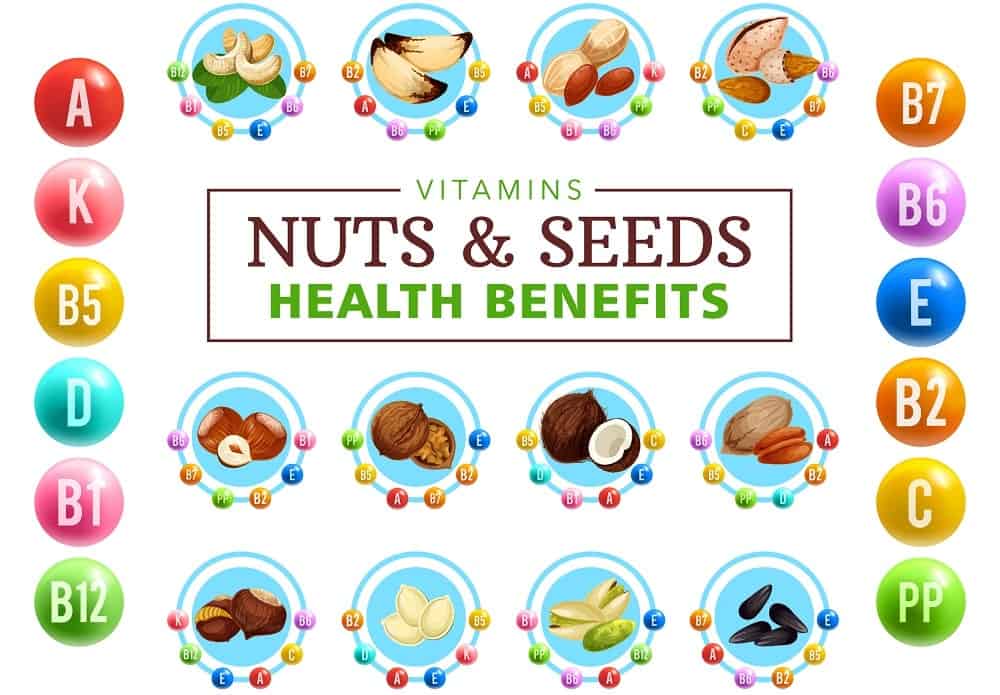
You don’t need sugar to make your oatmeal tasty. Adding in a variety of toppings can make your oatmeal savory, creamy, sweet, and even more nutritious. Fruit, nuts, and seeds add a ton of texture and flavor. Other popular toppings include yogurt, coconut flakes, and peanut butter.
If you really want a sweetener, add a dash of honey, maple syrup, or monk fruit sugar.
Spice it Up

Another quick way to jazz up the flavor of your oatmeal is by adding spices. Feel free to experiment with amounts and spice combinations. Popular spices for oatmeal include cinnamon, nutmeg, ginger, vanilla, and cardamom.
Overnight Oats
Over the past couple of years, overnight oats have overtaken the health world. They’re an easy breakfast to make, perfect for those on the go. To make overnight oats, you will need ½ rolled oats and 2/3 cup of your milk. Mix your oats and milk together and let it sit in the refrigerator overnight. That’s it!
Of course, these oats on their own would be rather plain and bland tasting. Just like your morning oatmeal, add in any ingredients to make your oatmeal tastier. This could include maple syrup, nut butter, cocoa powder, fruit, dried coconut, spices, and jams. Whatever you enjoy, stir it in with your oats and milk to sit overnight.
Make Granola
Making your own granola only takes a few minutes to prepare. Make a large batch so you have plenty of granola to enjoy with fruit, as a snack, or on top of some delicious yogurt.
To make granola:
- Mix together rolled oats, nuts, seeds, a hint of oil, some natural sweetener, salt, spices, dried fruit, and maybe some chocolate chips (after baking).
- Line a baking sheet with parchment paper and crowd the pan with your granola. (this will help create more clumps.)
- Bake at 350°F until lightly golden on top.
- Let it cool completely.
Enjoy it fresh, or store it in the freezer to hold on to the fresh-baked taste.
Muesli
Many lump muesli and granola together as the same thing, but there are a few key differences. First, granola is baked, while muesli is eaten uncooked. Secondly, muesli contains no added sugars, while granola requires a sweetener.
Mix rolled oats, nuts, seeds, and dried fruit to make muesli. Keep in mind that many dried fruits contain added sugar, so check the label before purchasing.
Oat Flour for Baking
Made from whole-grain oats, oat flour is packed with all the nutrients, protein, and fiber oats have to offer. While you can buy it from the store, it takes less than two minutes to make it home alone.
To make oat flour:
- Place rolled oats into a blender.
- Blend for 15 seconds.
- Give the blender a good shake or stir and then blend again.
- Repeat this until the oats are a fine powder.
- Transfer your oat flour to a jar and store it unrefrigerated for up to one month.
With this oat flour, you can bake or cook. Use it as an alternative to plain flour or add it to your recipes to adjust the texture.
Oat Milk
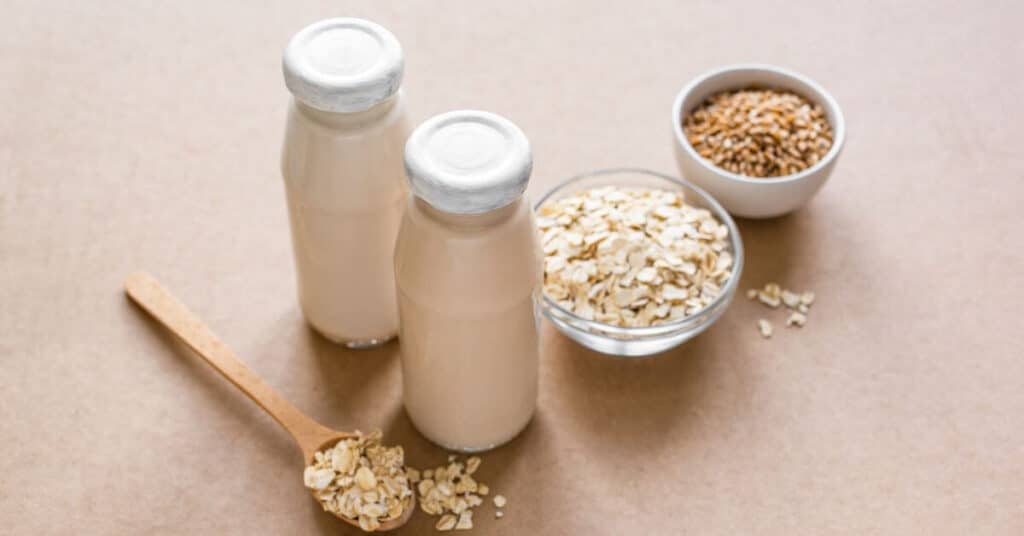
Another super popular oat product makes oak milk easily at home.
To make oat milk:
- Combine rolled oats with water and a pinch of salt in a blender. (To add sweetness, feel free to drop in a pitted date.)
- Blend for approximately 1 minute.
- Strain the oat milk into the bowl using a large bowl and a thin towel or cheesecloth.
- Repeat twice to ensure no oat residue sneaks its way through.
- Refrigerate and enjoy!
FAQs
Is Quaker Oats Keto-Friendly?
Quaker Oats are not keto-friendly, as they are high in carbohydrates. Most keto diets recommend limiting your daily carb intake to around 20-50 grams. One serving (1/2 cup or 40 grams) of Quaker Oats contains about 27 grams of carbs, which could push you over your daily limit.
Are Oats a Nut?
No, oats are not a nut. They are a type of cereal grain that comes from the oat plant. Although they are gluten-free, oats are often processed in facilities that also handle wheat, which may result in cross-contamination. Always check the packaging if you have any allergies or intolerances.
What Do Oats Taste Like?
Oats have a mild, slightly nutty flavor that can be enhanced or sweetened with various ingredients. When cooked with water or milk, they become soft and have a creamy texture. The taste of oats can be easily customized to your personal preference by adding fruits, spices, sweeteners, or even savory ingredients.
How Long Do Oats Take to Digest?
The digestion time for oats varies depending on the person and the type of oats you consume. In general, it takes around 3-4 hours for oats to be digested. Steel-cut oats, which are less processed, may take longer to digest than rolled oats due to their larger size and density. Eating oats with additional fiber or protein can also slow digestion time.
Can You Use Steel-Cut Oats for Granola?
You can use steel-cut oats for granola, but they will require longer cooking time to achieve the desired crunchiness. Steel-cut oats are more dense and chewy compared to rolled oats. To make granola with steel-cut oats, simply adjust your recipe’s baking time and keep an eye on the texture.
Can You Make Overnight Oats Without Chia Seeds?
Absolutely! Chia seeds are often added to overnight oats for extra texture, protein, and fiber, but they are not essential. You can easily make overnight oats without chia seeds by simply combining your oats with your preferred liquid (such as milk, yogurt, or a non-dairy alternative) and any additional mix-ins or flavors you desire. Allow the mixture to sit in the refrigerator for at least 4-6 hours, or overnight, before enjoying your delicious and nutritious breakfast.
